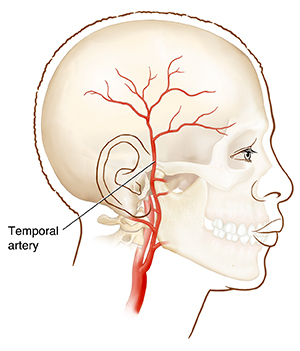Understanding Temporal Artery Biopsy
A biopsy is a procedure to take small samples of tissue from a site in your body. The tissue is then checked for signs of disease. In a temporal artery biopsy, a doctor will take tissue from one or both of your temporal arteries. These are blood vessels in the sides of your forehead (temples).

Why a temporal artery biopsy is done
This kind of biopsy is most often done to see if you have giant cell arteritis. This condition causes the lining of your arteries to become red, swollen, and irritated (inflamed). It can cause narrowing or a blockage of the arteries. Giant cell arteritis most often involves the temporal arteries. For this reason, it's also known as temporal arteritis. Prompt diagnosis and treatment of giant cell arteritis is important. That's because it can lead to problems, such as blindness and stroke.
How temporal artery biopsy is done
The biopsy is often done as an outpatient procedure. This means that you go home the same day. The time it takes can vary. During the procedure:
-
The skin over the biopsy site is cleaned. The biopsy site will be your right or left temple.
-
The doctor may use Doppler ultrasound to find the artery and mark the site with a pen.
-
Medicine may be put on the site to numb the skin. Local anesthetic is injected into the area. This helps prevent pain during the biopsy.
-
When the area is numb, the doctor makes an incision in the skin of the temple.
-
The doctor finds the artery and then clamps or ties off with stitches the section to be used for the biopsy. A small piece of the artery is cut from this section and removed. The doctor uses stitches or heat to seal the cut edges of the artery.
-
The skin incision is closed with stitches. A pressure bandage may be put over the site.
-
If needed, the doctor repeats the procedure in the other temple.
-
The sample of tissue from the artery is sent to a lab. The tissue is checked for signs of giant cell arteritis or other problems.
-
Your doctor will contact you with the results when they are ready.
Risks of temporal artery biopsy
Risks may include:
-
Bleeding.
-
A pocket of blood under the skin (hematoma).
-
Infection.
-
Scarring or hair loss at the incision site.
-
Nerve damage.
-
Being unable to get a diagnosis.
Online Medical Reviewer:
Esther Adler
Online Medical Reviewer:
Mahammad Juber Medical Researcher
Online Medical Reviewer:
Raymond Kent Turley BSN MSN RN
Date Last Reviewed:
5/1/2025
© 2000-2025 The StayWell Company, LLC. All rights reserved. This information is not intended as a substitute for professional medical care. Always follow your healthcare professional's instructions.